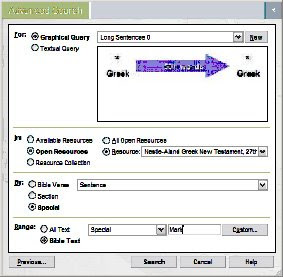A guest post by Tim Bahula, ardent Logos user
The Bible software showdown continues! When I read Rod Decker's article on finding complex sentences in Mark using Accordance, a spark was kindled. But not having a particular interest in complex sentences, in Mark, or in Accordance, it faded. When I read MVGH's article on doing the same search in Bibleworks, I knew that I need to try my hand at it in Logos.
Even though I've heard rave reviews about using Bibleworks for biblical research, my only experience with it was just after I completed my M.Div. in 1992. At the time I was a poor struggling graduate and couldn't justify the expense of Bible study software. When I had money a few years later, I purchased Logos Bible software and have since made a significant investment in adding library resources. So I want to make it work.
My search approach was spawned by a comment made by Mike on MVGH's entry. He suggested,
"I do think it could be done with a graphical query though, since Logos also allows crossing verse boundaries."
My method was to use a graphical query to find any two words in the same sentence separated by 50 or more words. This search is easy and fast to set up, it runs fast, and it produces accurate results that are easy to interpret and screen.
If you just want the results, the search returns Mark 2:25-26; 3:7-8; 4:31-32; 5:2-4; 5:25-27; 6:7-9; 7:2-5a; 10:29b-30; 10:32b-34; 13:14-16.
If you want to run it for yourself, you can download the graphical query here. You'll need these parameters in the search dialog:

Here are the steps to follow.
- Open the Gramcord NA 27
- Start a graphical query using from the menu: File > New > Graphical Query - Provide the name you want and hit OK
- Drag a TERM object into the search window
- When the dialog opens, select Language = Greek, Term = * > OK
- Repeat the previous two steps to create a second TERM object identical to the first
- Now draw a line from the first (left-most) object to the second (right-most) object (If you haven't drawn lines before, it is a matter of moving your cursor near an object until a gray arrowhead appears and then dragging it to the desired object to be connected)
- Double-click on the line just created
- In the dialogue, set your proximity to "At least 50 intervening" > OK
- Click on the Search icon at the top left > When the Advanced Search dialogue box opens, make sure you are using Nestle-Aland 27 with Gramcord; select to search By: Special and choose Sentence; limit your range to a Bible Text, and type in a single book (in this case, Mark) >> Hit Search
- On my older PentiumM, 1.86Ghz with 2Gb RAM WinXP system, the search took about 2 minutes to run
Do not be dismayed if it looks like you only get one hit! Click on "Concordance at the top right of the box, then sort "By reference." The verses listed indicate the end of a sentence just prior to a sentence with 50+ words. (Note Vincent's observation above about 'words' in in the graphical query editor. I.e., there will be some sentences with less than 50 words.)My method described above avoids all of these problems except for the "word" count problem inherent in Logos. MVGH also highlighted the way that Logos handles the semi-colon, which will affect the results returned.
Now click on one of the references to open up the NA27 text.You will have to scan through the results, but note that there are colored markers to indicate the major stop before a long sentence and a different colored marker at the end of the sentence. (emphasis added)








Very elegant. Wild card 'word' searches in Libronix normally take forever, so it appears that the Sentence constraint works quite efficiently.
ReplyDeleteNote that it works with most flavours of NA27/UBS4, and UBS4 has more results as semi-colons are ignored.
With a proximity of over 90 words, UBS4 shows the longest sentences are in:-
ReplyDeleteMark 2:6-11; 2:24-28; 3:14-19; 7:2-7; 14:12-15. The longest is 7:2-7 followed by 2:6-11.
Decker (http://ntresources.com/blog/?p=298) identified the longest, in order, in Mark as: 3:14–19; 5:2–5; 5:25–28; 7:2–5; 10:29–30; 10:32b–34; 13:14–16.
ReplyDeleteYour results, Dave, appear to ignore question marks as well as semicolons.
Decker's longest are presented in canonical order.
ReplyDeleteI can replicate ALL his results in UBS4 except for Mk 7:2-5, where UBS4 has a semi-colon after v5 and lists vv 2-7.
UBS4 also lists Mk 2:6-11 (100 words) and Mk 2:24-28 (88 words). Decker may not include them because the Accordance GNT-T(?) has different punctuation or sentence structure, but they are definitely in my top 7! The word counts are manual and Mk 7:2-7 is 121 words!
UBS4 has slightly different punctuation to NA27, but none of the results include a Question Mark. Perhaps the Accordance GNT has question marks where UBS4 produces the results in chapter 2?
I think the problem comes with comparing apples and oranges... or in this case, Greek punctuation and English punctuation.
ReplyDeleteI also found that UBS4 produced far different results. As I investigated several examples, I realized that the UBS4 sentences extend through Greek semi-colon (English question marks). See, for example, Mark 2:6-11. It is comprised of 4 questions.
The search differences arise from tagging differences, highlighting the fact that it is imperative that one knows the tagging scheme, that it has been applied consistently to the text and that results are manually verified.